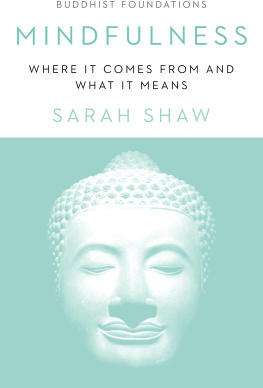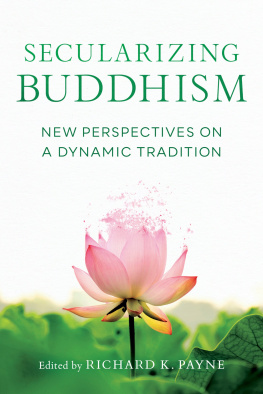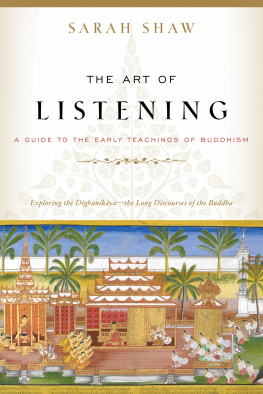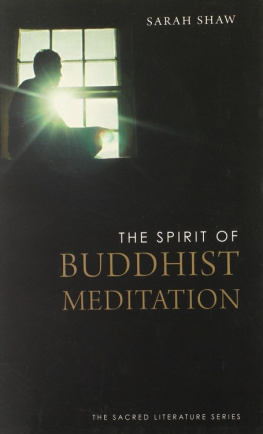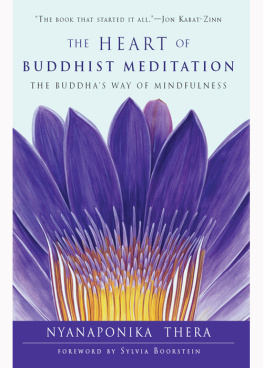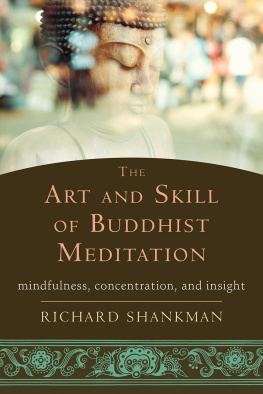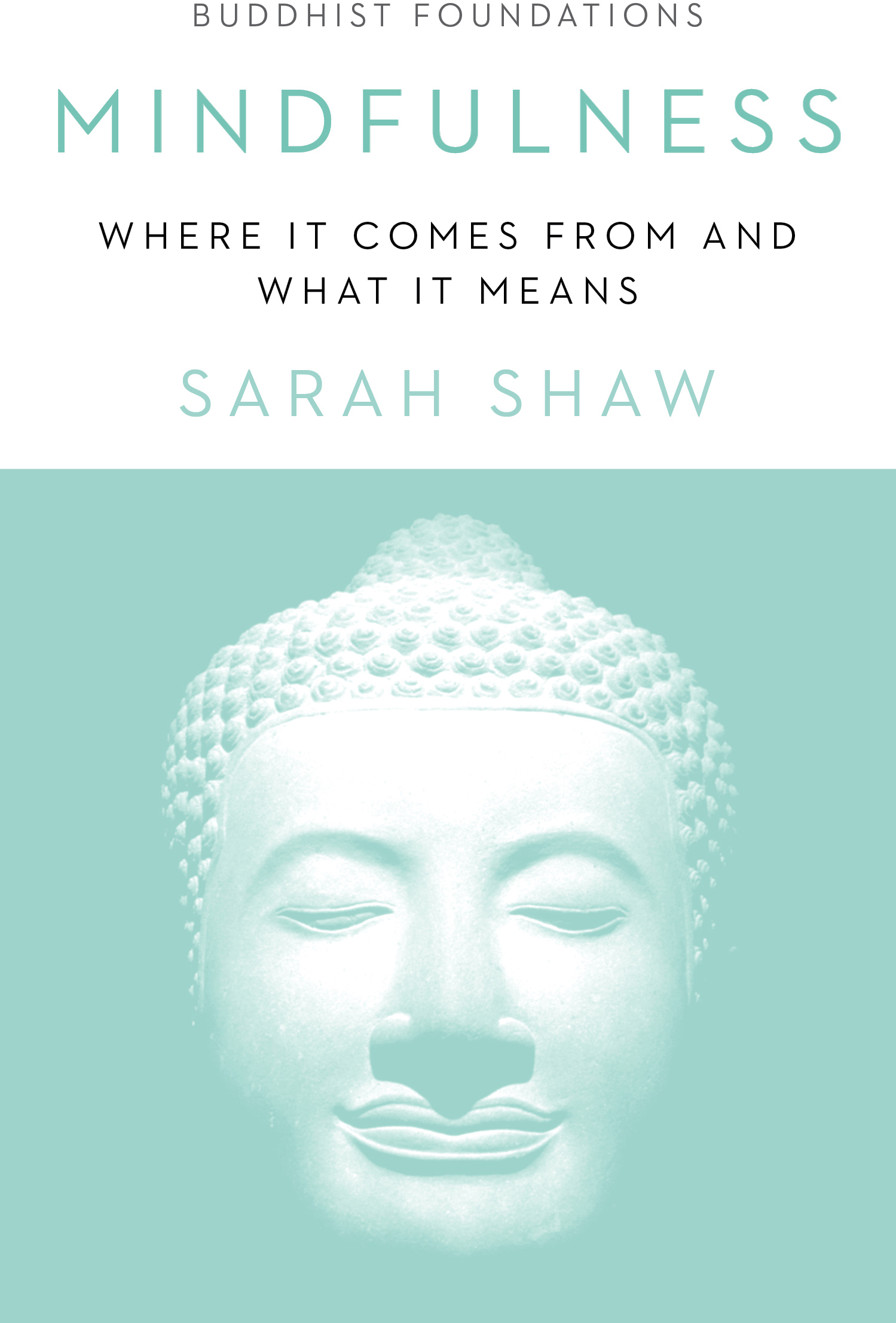Contents
Landmarks
Print Page List
This book enables the reader to understand mindfulness with scholarly wisdom and a skillful modern application.
J ACK K ORNFIELD , author of The Wise Heart
What is mindfulness? Is it a scientifically proven method for reducing stress? An evidence-based strategy for improving performance? A path to complete liberation from suffering? Or is it simply a way to live a more contented life? With directness and warmth, Oxford Universitys Sarah Shaw explains why the answer to each of these questions is yes. Her expertise (and storytelling ability) as both an academic and a practitioner take mindfulness out of the pop culture loop to give us the historic and spiritual meanings of the word. This illuminating book is for anyone who wants to discover the true potency of mindfulness that may otherwise be obscured by our self-help leanings.
S USAN P IVER , author of Start Here Now
In this insightful book, Sarah Shaw chronicles not only how mindfulness has played a central role in Buddhist meditative practices but how it is embedded in a complete system for liberation, undergirded by ethical sensibilities. Illuminating the genealogy of mindfulness and how this term has been rendered historically in a wide range of Buddhist teachings, readers will gain a deeper appreciation for a practice that goes far beyond a modern simplification of simply being in the present moment.
R ONALD P URSER , author of McMindfulness
Shambhala Publications, Inc.
4720 Walnut Street
Boulder, Colorado 80301
www.shambhala.com
2020 by Sarah Shaw
Cover credit: Art Khmer Buddha Head kept at the Muse national des arts asiatiquesGuimet, Paris. Photo by Tony Bowall FRPS (UK),
www.tonybowallphotography.com
Cover design: Sarah Brody
Interior design: Claudine Mansour Design
All rights reserved. No part of this book may be reproduced in any form or by any means, electronic or mechanical, including photocopying, recording, or by any information storage and retrieval system, without permission in writing from the publisher.
L IBRARY OF C ONGRESS C ATALOGING - IN -P UBLICATION D ATA
Names: Shaw, Sarah (Scholar of Buddhism), author.
Title: Mindfulness: where it comes from and what it means / Sarah Shaw.
Description: First Edition. | Boulder: Shambhala, 2019. | Series: Buddhist foundations | Includes bibliographical references and index.
Identifiers: LCCN 2018054144 | ISBN 9781611807196 (pbk.: alk. paper)
eISBN 9780834842281
Subjects: LCSH: MeditationBuddhism. | Mindfulness (Psychology)
Classification: LCC BQ5612 .S534 2019 | DDC 294.3/4435dc23
LC record available at https://lccn.loc.gov/2018054144
v5.4
a
CONTENTS
ACKNOWLEDGMENTS
I would particularly like to thank Robert Adkins, Dr. James Benson, Dr. Francis Beresford, Boonman Poonyathiro, Professor John Brockington, Jackie Callow, Dr. Helen Close, Dr. Paul Dennison, Ven. Dr. Dhammasmi, Dr. Roger Farmer, Bernat Font, Professor Richard Gombrich, David Hall, Dr. Rachael Hall, Marjorie Jacks, Dr. Tony James, Dr. Charles King, Sarah Matheson, Anne Schilizzi, Dr. Peter Skilling, Rebecca Small, Dr. Rafael Stepien, Dr. Nick Swann, Fiona Thomas, Miranda Walker, and Sarah Yorke, for discussions. Thanks also to Casey Kemp and Nikko Odiseos at Shambhala for their friendly encouragement.
I am also grateful to friends at Wolfson College, students at OUDCE, and my ever-cheering Elsfield Book Club friends, as well as fellow practitioners in the Samatha Association.
As always, my deepest gratitude and thanks are to Charles and my family.
PREFACE
In the fifth century BCE , in India, the Buddha changed the use of the Sanskrit word for memory (smti). The new meaning appeared quite different; as sati, in Pli, it came to be associated with an attentive awareness to present events, what we now know in English as mindfulness. Mindfulness became a central feature of the Buddhas eightfold path and a crucial element in the theory and practice of Buddhism as it traveled throughout Asia. It also became a key element in Buddhist psychology and formulations of the nature of the human mind, where it is important in clearing the mind of problems and stale repetitive patterns. Mindfulness informs this psychology. It is also a transformative factor in the practice of meditation and good ethical behavior in the world, freeing the mind from views and opinions that bring about unhappiness.
In the late twentieth century, a number of therapies and techniques associated with cultivating mindfulness, derived for the most part from Buddhist practice, successfully treated depression and some other disorders. The psychological professions were revolutionized by some basic mindfulness techniques, which changed many peoples lives completely. Using methods originally suggested by the Buddha, people found radically different ways of working with their problems and began to see them with different perspectives. The theory behind these techniques, however, was largely linked to Western psychological formulations of the nature of the mind. Most therapists and clinicians acknowledge the Buddhist roots of these techniques, but the larger context of how mindfulness is understood and relates to other mental states in Buddhist psychology is rarely explored.
Buddhism has taught mindfulness as one of its central teachings. But it has also taught quite a few other things too. Mindfulness is one crucial part of a complete system of understanding the operation of the mind and the ways it can develop. So its nature is very different from its application in Western psychological models. Indeed, memorythe ancient Sanskrit meaning of the wordstill plays an important part. Mindfulness is said always to work with other elements that support it and that it supports. Within the terms of Buddhist psychology, it simply cannot arise alone and likes company. When it arises, factors associated with it give it an ethical dimension, and other qualities arise too, such as loving kindness, compassion, sympathetic joy, and equanimity. It is found in daily life and is also essential for deep meditations known as jhnas. It is also, again with other factors, a faculty that is said to bring liberating insight and to free the mind completely.
This book, which is intended for the general reader as well those with a special interest in Buddhism, gives a brief history as to how the term sati, or mindfulness, has been taught and practiced historically in the Buddhist traditions and how it fits with other aspects of the Buddhist path. Some geographical, as well as historical, shifts in usage also emerge. It is hoped that for those who are interested in the background of the word, its meaning and application will become clearer and set in a larger context. This book also suggests that Buddhist understandings of psychology, of living in the moment, and of the benefits to be derived from this are more far-reaching than is suggested by many usages of the term mindfulness in the modern world.
DIFFERENT KINDS OF TEXTS
In looking at the history of something so central to Buddhist practice and theory, it is important not to consider Buddhist texts as philosophical tracts, operating purely on the abstract level of ideas, though many work well at that level too. In many texts, mindfulness is described, evoked, linked to other aspects of the mind and the teaching; it is taught and encouraged in a variety of ways. As we shall see, different kinds of texts suggest and locate it differently just by their very style and nature. Some early poems enjoin mindfulness in ways that we find throughout the history of Buddhism, in a less formal setting. Some early canonical texts place it more systematically in the context of other factors that tend to arise with it or where it is one part of a sequence or an assemblage of factors, performing a particular role in each. These early texts are crucial to our understanding of mindfulness, but we do not have to insist that they are the only valid ones and thereby do exactly what they tell us not to: form views and partial identifications about their authority and rightness. The austere simplicity of early verses that evoke mindfulness represents one style; they are often heart-based responses or pared-down evocations of a way of finding particular states of mind and a changed mode of being, rather than strict definitions.

